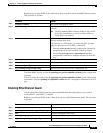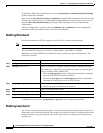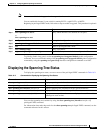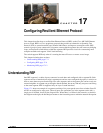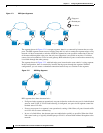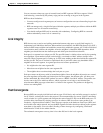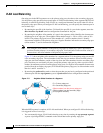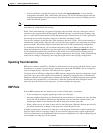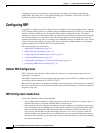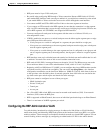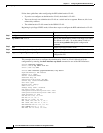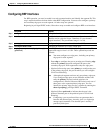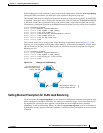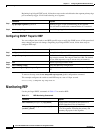
17-5
Cisco ME 3400 Ethernet Access Switch Software Configuration Guide
OL-9639-06
Chapter 17 Configuring Resilient Ethernet Protocol
Understanding REP
• You can configure a preempt delay time by entering the rep preempt delay seconds interface
configuration command. After a link failure and recovery, VLAN load balancing begins after the
configured preemption time period elapses. Note that the delay timer restarts if another port fails
before the time has elapsed.
Note When VLAN load balancing is configured, it does not start working until triggered by either manual
intervention or a link failure and recovery.
When VLAN load balancing is triggered, the primary edge port then sends out a message to alert all
interfaces in the segment about the preemption. When the message is received by the secondary edge
port, it is reflected into the network to notify the alternate port to block the set of VLANs specified in
the message and to notify the primary edge port to block the remaining VLANs.
You can also configure a particular port in the segment to block all VLANs. VLAN load balancing is
initiated only by the primary edge port and is not possible if the segment is not terminated by an edge
port on each end. The primary edge port determines the local VLAN load balancing configuration.
To reconfigure load balancing, you reconfigure the primary edge port. When you change the load
balancing configuration, the primary edge port again waits for the rep preempt segment command or
for the configured preempt delay period after a port failure and recovery before executing the new
configuration. If you change an edge port to a regular segment port, the existing VLAN load balancing
status does not change. Configuring a new edge port might cause a new topology configuration.
Spanning Tree Interaction
REP does not interact with STP or with the Flex Link feature, but can coexist with both of them. A port
that belongs to a segment is removed from spanning tree control and STP BPDUs are not accepted or
sent from segment ports. Therefore, STP cannot run on a segment.
To migrate from an STP ring configuration to REP segment configuration, begin by configuring a single
port in the ring as part of the segment and continue by configuring contiguous ports to minimize the
number of segments. Each segment always contains a blocked port, so multiple segments means multiple
blocked ports and a potential loss of connectivity. When the segment has been configured in both
directions up to the location of the edge ports, you then configure the edge ports.
REP Ports
Ports in REP segments take one of three roles or states: Failed, Open, or Alternate.
• A port configured as a regular segment port starts as a failed port.
• Once the neighbor adjacencies are determined, the port transitions to alternate port state, blocking
all VLANs on the interface. Blocked port negotiations occur and when the segment settles, one
blocked port remains in the alternate role and all other ports become open ports.
• When a failure occurs in a link, all ports move to the failed state. When the alternate port receives
the failure notification, it changes to the open state, forwarding all VLANs.
A regular segment port converted to an edge port, or an edge port converted to a regular segment port,
does not always result in a topology change. If you convert an edge port into a regular segment port,
VLAN load balancing is not implemented unless it has been configured. For VLAN load balancing, you
must configure two edge ports in the segment.



